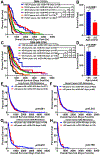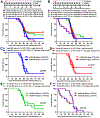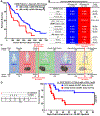Advanced Age Increases Immunosuppression in the Brain and Decreases Immunotherapeutic Efficacy in Subjects with Glioblastoma
- PMID: 32546647
- PMCID: PMC7541490
- DOI: 10.1158/1078-0432.CCR-19-3874
Advanced Age Increases Immunosuppression in the Brain and Decreases Immunotherapeutic Efficacy in Subjects with Glioblastoma
Abstract
Purpose: Wild-type isocitrate dehydrogenase-expressing glioblastoma (GBM) is the most common and aggressive primary brain tumor with a median age at diagnosis of ≥65 years. It accounts for approximately 90% of all GBMs and has a median overall survival (OS) of <15 months. Although immune checkpoint blockade (ICB) therapy has achieved remarkable survival benefits in a variety of aggressive malignancies, similar success has yet to be achieved for GBM among phase III clinical trials to date. Our study aimed to understand the relationship between subject age and immunotherapeutic efficacy as it relates to survival from glioma.
Experimental design: (i) Clinical data: GBM patient datasets from The Cancer Genome Atlas, Northwestern Medicine Enterprise Data Warehouse, and clinical studies evaluating ICB were stratified by age and compared for OS. (ii) Animal models: young, middle-aged, and older adult wild-type and indoleamine 2,3 dioxygenase (IDO)-knockout syngeneic mice were intracranially engrafted with CT-2A or GL261 glioma cell lines and treated with or without CTLA-4/PD-L1 mAbs, or radiation, anti-PD-1 mAb, and/or a pharmacologic IDO enzyme inhibitor.
Results: Advanced age was associated with decreased GBM patient survival regardless of treatment with ICB. The advanced age-associated increase of brain IDO expression was linked to the suppression of immunotherapeutic efficacy and was not reversed by IDO enzyme inhibitor treatment.
Conclusions: Immunosuppression increases in the brain during advanced age and inhibits antiglioma immunity in older adults. Going forward, it will be important to fully understand the factors and mechanisms in the elderly brain that contribute to the decreased survival of older patients with GBM during treatment with ICB.
©2020 American Association for Cancer Research.
Conflict of interest statement
Figures






References
Publication types
MeSH terms
Substances
Grants and funding
- R01 CA211229/CA/NCI NIH HHS/United States
- F32 NS073366/NS/NINDS NIH HHS/United States
- R01 NS117104/NS/NINDS NIH HHS/United States
- R00 NS082381/NS/NINDS NIH HHS/United States
- T32 CA009560/CA/NCI NIH HHS/United States
- R01 NS097851/NS/NINDS NIH HHS/United States
- R01 NS102669/NS/NINDS NIH HHS/United States
- K99 NS082381/NS/NINDS NIH HHS/United States
- K02 AG068617/AG/NIA NIH HHS/United States
- P50 CA211015/CA/NCI NIH HHS/United States
- R01 NS113352/NS/NINDS NIH HHS/United States
- T32 CA070085/CA/NCI NIH HHS/United States
- R01 NS113425/NS/NINDS NIH HHS/United States
- P50 CA221747/CA/NCI NIH HHS/United States
- UL1 TR001422/TR/NCATS NIH HHS/United States
- R01 CA103320/CA/NCI NIH HHS/United States
LinkOut - more resources
Full Text Sources
Other Literature Sources
Research Materials

